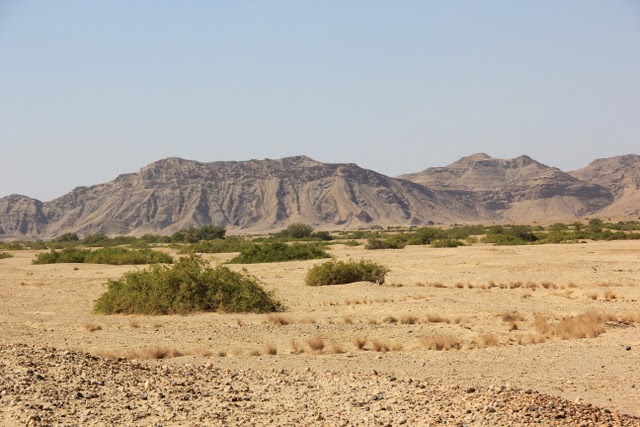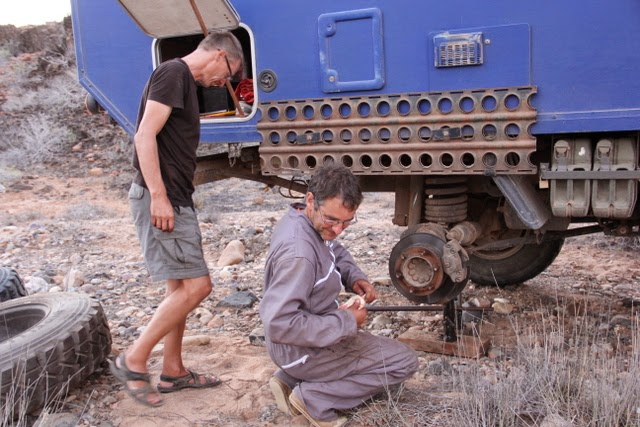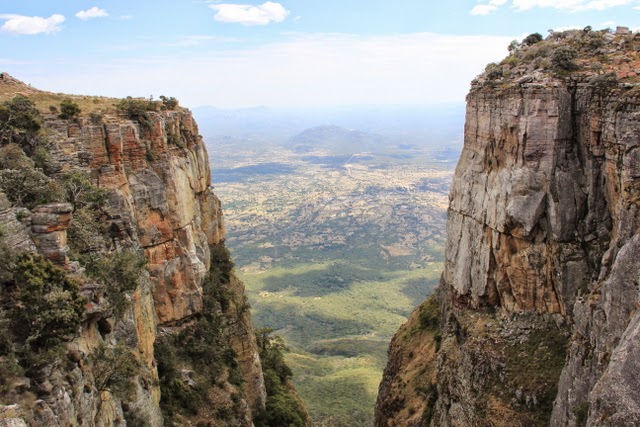As mentioned in the previous blog-entry being in Namibia is
like being back in civilization and vacationing in any other tourist
destination. We can get money again, there are many hotels/lodges/campgrounds,
each town has a decent supermarket and anything you need it can be found in the
bigger towns and they speak English!!!. However keep in mind that Namibia is huge and with only 2 million
people, the towns are spread out, so you can drive for hours or days (depending
what area of the country you are visiting) before you get to a decent size
town.
Our first stop was Odangwa, together with Oshakati
designated by the current government as the next economical center of Namibia.
These towns are in the north of Namibia and the current president is from the
area. We actually almost got arrested because of the president. On our way from
Oshakati to Odangwa we did not get off the road quick enough when some police
cars came from behind us. We slowed down and gave them plenty of room to pass.
But when we did not get off the road they came driving next to us and indicated
that we had to get off the road. So we did, also because we noticed that all
the locals went off the road. We still did not know why, was there a new oil
crisis and they did not want any cars driving around anymore? When we pulled
over we asked a local and he told us that the president had attended a birthday
party and was on his way back to the airport. And yes a couple of minutes later
some big SUVs came racing by. We waved to the president and we are very proud to
say that he waved back to us. He did not stop nor did he slow down for us, but
we think that it was because he was about to miss his flight, so he was
excused.
Any way we stayed a couple of days in Odwanga to resupply
Rosana’s food storage compartments, buy little things for the car, look for a
place to refill the gas bottle or LPG tank (was not possible), get the computer
fixed, catch up on e-mails etc.. We stayed at Odwanga rest camp and enjoyed
some nice dinners and biltong there.
After a few days we drove into Etosha where we spent 12 days
driving from waterhole to waterhole watching animals while having breakfast,
lunch and coffee with freshly baked caked. Yes, all from our mobile home!! Rosana
was wondering if a cake was ever baked while watching some elephants drink and
play at a waterhole…
Below there are some of the pictures from the animals we saw in Etosha. For more pictures go to the page "Photos/Info - Per Country" from our main page then click on Namibia
 |
| "These trees are bloody far away" |
 |
| With Sonja and Jeroen at the Etosha pan |
 |
| "I own this waterhole" |
 |
| Grumpy black rhino chasing away zebra |
It was great as always. Already on our first full day we saw
lions for breakfast, mating leopards for lunch and cheetahs during sundowners.
We also treated ourselves to a stay at Dolomite camp at the western end of
Etosha. You are only allowed to drive in that area if you have a reservation
for the lodge. We wanted to leave Etosha on the western exit because it
was closer to Kamanjab where there is someone who claims that he is an expert
in Unimogs.
The drive in the western part of Etosha was nice, there was
a waterhole every 10-15km, although some of them were dry, and we saw lots of
animals. Dolomite camp is set on a hill and our chalet had a beautiful view
over the plain and we could see lots of animals.
 |
| Dolomite Camp |
The next day it was an easy drive to Kamanjab, where we
stayed for almost a week. The owners of the Campground/lodge Oppi-Koppi are
from Belgium/Holland and they let overlanders stay for free. We had a nice
campsite all the way at the back of the property with a covered area, braai,
water, light and electricity and a very clean ablution block with hot showers.
We spent a day at the Unimog garage where we had the car
checked and some minor things fixed (splitter gear, leaking oil pump, leaking
wheel hub, new brakes). The rest of the time we spent reading, being lazy,
cleaning the car, installing 12volt charger in the box, re-sealing the
bathroom, fixing the heater in the box etc.
After this relaxing week it was back to the bush. We spent 6 days in the Palmwag conservancy area and drove from Palmwag to
Sesfontein. It was very nice, the nature is very rugged desert terrain but with
animals (we saw black rhino, desert elephants, kudu, springbok, steenbok,
gemsbok, giraffe, mountain zebra, baboons and jackals). We heard lions but we
did not see them. It was all wild camping, we stayed in some amazing spots, and
best of all we hardly saw any other people. The first three days we saw two cars,
the last three days we did not see anyone.
 |
| Damaraland |
 |
| Viewing deck |
 |
| On the last day we found the desert elephants |
After we left Sesfontein we stayed at a campsite in the
Khowarib Canyon. We had a nice spot with a view of the river (although after
the drought in Namibia it looked more like a creek).
The next day we wanted to
take a shortcut back to Kamanjab by following the Khowarib river upstream.
Normally we ask locally about the condition of the road, but this time we
forgot (well… Marc actually did not want to ask anything… as always), mainly
because the road was on a map and it was numbered. However, after about 2 km we
had a river crossing with a very steep and bad uphill on the other side. You
can see on one of the pictures below that the Unimog was on three wheels.
 |
| "Put your tyres in the air" |
 |
| Duma goes anywhere |
It was very
slow going the next three kilometers as well and then the riverbed widened and
was one big hardened mud pool with deep tracks and low trees. We had difficulty
finding the right track and after about half an hour Rosana had enough because
at this speed it would take us three days to cover the 70km to the main road to
Kamanjab. So we decided to go back to the lodge and inquire about the road. At
the lodge the owner asked whether we did the river crossing? yes we did, did
you we get past the steep rocky part with deep drop off? yes we did, did we get
to the place where the river bed widens and you have all the deep tracks? yes
we did. OK then you have driven the worst part of the track. So back we went to
find out that we had turned around only 100 meters before the roughest part of
the trail finished. We lost about two hours but at least Marc had a fun time
driving (Rosana, not so much)
Towards the end of the trail in the middle of nowhere there
was a veterinary gate where they check for meat and dairy products. We knew
about this so we had removed the meat from the freezer. It is just incredible
that they have this checkpoint in a place where there are maybe two or three
cars a day passing by.
Right now we are back in Kamanjab, the splitter gear has
been fixed and we will head back into Damaraland the day after tomorrow.









































